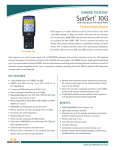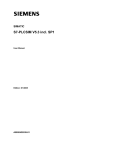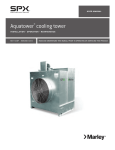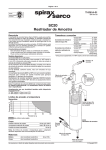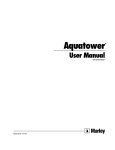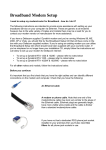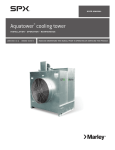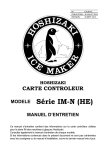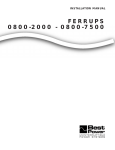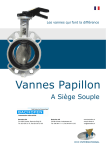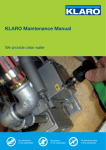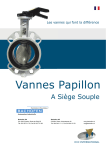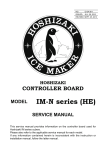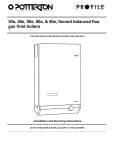Download Marley Cooling Tower Basic Control System User Manual
Transcript
/ Marley Basic Control System / User Manual 92-1320E ! Warning This manual contains vital information for the proper installation and operation of your cooling tower and the basic control system. Carefully read the manual before installation or operation of the tower. Failure to follow the instructions in this manual may result in substantial personal injury or death. Save this manual for future reference. Table of Contents Introduction.................................................................................................................2 Safety............................................................................................................................3 Factory Installation.....................................................................................................4 Field Connection........................................................................................................6 AquaTower...........................................................................................................6 NC Tower – Standard.......................................................................................7 NC Tower – Motor Outside Option...............................................................7 NC Tower – Modular.........................................................................................8 Field Connection..................................................................................................... 10 Field Installed Systems – Single Speed Motor........................................ 10 Field Installed Systems – Two Speed Motor............................................ 11 Control System Operation.................................................................................... 12 Single Speed Manual..................................................................................... 12 Two Speed Manual......................................................................................... 13 Single Speed Automatic............................................................................... 14 Two Speed Automatic.................................................................................... 16 System Maintenance.............................................................................................. 18 Contacts............................................................................................................ 18 Coils................................................................................................................... 18 Fuses and Thermal Overloads..................................................................... 18 Visual Inspections........................................................................................... 18 Single Speed Wiring Details – 3 Phase............................................................ 19 Two Speed Wiring Details.................................................................................... 20 AC Starter Wiring Schematic.............................................................................. 22 Parts List Single Speed Motor....................................................................................... 31 Two Speed Motor............................................................................................39 Trouble Shooting.....................................................................................................44 3 Introduction The Marley Basic Control System purchased on this tower represents the most economical and reliable automatic control system available. Since the system is factory tested and all components are operationally tested, you can have confidence the system will perform as specified. These instructions—as well as those offered separately—are intended to assure that Field connections are completed properly and the control system serves you for the maximum possible time. Since product warranty may depend on your actions, please read these instructions thoroughly prior to operation. If you have questions about the operation and/or maintenance of this control system, and you do not find the answers in this manual, please contact your Marley sales representative. When writing for information, or when ordering parts, please reference the Marley customer order number on the tag inside the door of the control panel. Warning 4 Hazard of electrical shock or burn. Be sure to turn off power to panel before servicing. If working on equipment out of sight of panel disconnect, lockout using standard lock-out procedure. Safety The Marley control system uses UL listed components installed in accordance with the National Electrical Code. The location of the cooling tower and field installation of the control system can affect the safety of those responsible for installing, operating or maintaining the tower and controls. However, since SPX Cooling Technologies does not control the tower location, or field installation, we cannot be responsible for addressing safety issues that are affected by these items. The following safety issues should be addressed by those responsible for installation, maintenance or repair of the tower and controls: • Access to and from the control panel (including the disconnect switch). • Proper grounding of electrical control circuits. • Sizing and protection of branch circuits feeding the control panel. • Qualification of persons who will install, maintain and service the electrical equipment. These are only some of the safety issues that may arise in the design and installation process. SPX strongly recommends that you consult a safety engineer to be sure that all safety considerations have been addressed. Other safety issues are addressed in literature supplied with your tower. You should closely review the literature prior to installing, maintaining or repairing your tower. 5 Factory Installation The control panel bolts directly to the tower with spacers or to a bracket attached to the tower. The thermostat is bolted to the tower casing adjacent to the cold water basin depressed section. The capillary runs through a bushing in the tower casing and the bulb is installed vertically in a holder near the outlet for proper temperature measurement. The holder is “glued” to the cold water basin floor with a layer of sealer applied to its bottom flange and the bushing through which the capillary passes is filled with sealer to protect the capillary. ® A vibration limit switch is mounted near the Geareducer on larger towers and near the motor on belt driven towers. Liquid tight flexible metal conduit connects all points which are to be wired—motor, control panel, thermostat and vibration limit switch, if required. The conduit is installed with associated couplings, connectors and fittings approved for this conduit and is also supported by conduit clamps as required by code. After the completion of the conduit installation, the wiring is pulled through the conduit to each component. Pulling type fittings are used to provide access for pulling the wire and meeting the N.E.C. requirement for maximum number of bends allowed in each conduit run. All wire ends are tagged for identification and connections at each end are made at terminal blocks or by terminal connectors with fasteners. 6 Factory Installation Overload units are selected based upon the full-load current as read from the motor nameplate. Fuses are selected based upon the motor voltage and fullload current (high speed current on two speed motors) as listed in the National Electric Code. The overload units are installed into the motor starter and the time delay fuses are installed into the fuse clips with the grooved end on the bottom. (A bar in the fuse clip requires the use of a time delay fuse which has a groove to fit over the bar.) The time delay relay on the two speed control panel is adjusted for a 30 second or more delay and the thermostats are preset as follows: One Speed Cut-in Temperature 85° F Cut-out Temperature 80° F 72°F Two Speed The completed factory installation is tested by cycling the fan off and on both manually and automatically with the control panel switches and the thermostat respectively. 7 Field Connection Note The factory installation by Marley has been performed in accordance with the National Electrical Code using UL Listed components. All installation and wiring performed after leaving the factory must be performed in accordance with the latest revision of the National Electrical Code and any local codes to insure safe operation. The Marley Basic Control System has been factory tested to the fullest extent possible. Some equipment selections and options require the installation be completed in the field. The following information is provided as an overview of the field installation for the various options. Please refer to the drawings supplied with the tower for more detailed instructions to complete the installation. Warning HAZARD OF ELECTRICAL SHOCK OR BURN. BE SURE TO TURN OFF POWER to panel before servicing. If working on equipment out of sight of panel disconnect, lockout using standard lock-out procedure. AquaTower 1. Incoming power and ground lines must be run through the opening provided on the top of the control panel. Conduit must be connected to the panel using a watertight or raintight fitting. Power connections are made at the top of the fusible disconnect located in the upper right hand corner of the control panel. The ground wire must be connected to the ground bar located at the bottom of the control panel cabinet. 2. After completing the electrical connections to the panel, provide power to the panel, operate the system in the “manual” mode and verify proper direction of fan rotation on the tower. If the direction of rotation is incorrect, turn off power supplying the panel and reverse any two power leads at the fusible disconnect switch in the control panel. 3.The temperature and differential set points have been preset at the factory. Check the settings and adjust as necessary to suit your operating requirements. Be sure to maintain adequate differential between the cut-in and cut-out settings or excessive cycling of the fan motor may occur and shorten equipment life. 8 Field Connection NC Tower—Standard 1. Install temperature sensing element in its final position on the basin floor as near the basin outlet as possible. Sealer is used to attach the bracket to the basin floor. 2. Incoming power and ground lines must be run through the opening provided on the top of the control panel. Conduit must be connected to the panel using a watertight or raintight fitting. Power connections are made at the top of the fusible disconnect located in the upper right hand corner of the control panel. The ground wire must be connected to the ground bar located at the bottom of the control panel cabinet. 3. After completing the electrical connections to the panel, provide power to the panel, operate the system in the “manual” mode and verify proper direction of fan rotation on the tower. If the direction of rotation is incorrect, turn off power supplying the panel and reverse any two power leads at the fusible disconnect switch in the control panel. 4. The temperature and differential set points have been preset at the factory. Check the settings and adjust as necessary to suit your operating requirements. Be sure to maintain adequate differential between the cut-in and cut-out settings or excessive cycling of the fan motor may occur and shorten equipment life. NC Tower—Motor Outside Option 1. Insert the power leads and ground wire for the motor through the conduit opening in the motor junction box. Connect the conduit to the motor junction box. The motor power leads have been marked to match the motor leads for easy reconnection in the field. Make pigtail connections at the motor using hardware to fasten motor lug to the ring terminal on the power lead wire from the control panel. Wrap the pigtail with insulation putty to smooth out the points and edges, wrap the pigtail completely with vinyl electrical tape. Connect the ground lead to the ground lug inside the motor conduit box. 2. Install temperature sensing element in its final position on the basin floor as near the basin outlet as possible. Sealer is used to attach the bracket to the basin floor. 9 Field Connection 3. Incoming power and ground lines must be run through the opening provided on the top of the control panel. Conduit is connected to the panel using a watertight or raintight fitting. Power connections are made at the top of the fusible disconnect located in the upper right hand side of the control panel. The ground wire must be connected to the ground bar located at the bottom of the control panel cabinet. 4. After completing the electrical connections to the panel, operate the system in the “manual” mode and verify proper direction of fan rotation on the tower. If the direction of rotation is incorrect, turn off power supplying the panel and change any two power leads at the fusible disconnect switch in the control panel. 5. The temperature and differential set points have been preset at the factory. Check the settings and adjust as necessary to suit your operating requirements. Be careful to maintain adequate differential between the cut-in and cut-out settings or excessive cycling of the fan motor may occur and shorten equipment life. NC Tower—Modular 1. After the modules have been assembled, run the conduit from the control panel to the motor and vibration switch. 2. Place the power leads and ground wire for the motor through the conduit opening in the motor junction box. Connect the conduit to the motor junction box. The motor power leads have been marked to match the motor leads for easy reconnection in the field. Make pigtail connections at the motor using hardware to fasten motor lug to the ring terminal on the power lead wire from the control panel. Wrap the pigtail with insulation putty to smooth out the points and edges and wrap the pigtail completely with vinyl electrical tape. Connect the ground lead to the ground lug inside the motor conduit box. 3. If a vibration switch is installed, feed the wires through the conduit opening on the switch, connect the conduit to the threaded switch opening, connect the wires to the normally closed contacts of the vibration switch and connect the ground wire. Slope conduit away from switch if possible to avoid condensation in the switch. 10 Field Connection 4. Support the conduit at appropriate locations in accordance with the requirements of the National Electrical Code. 5. Install temperature sensing element in its final position on the basin floor as near the basin outlet as possible. Sealer is used to attach the bracket to the basin floor. 6. Incoming power and ground lines must be run through the opening provided on the top of the control panel. Conduit must be connected to the panel using a watertight or raintight fitting. Power connections are made at the top of the fusible disconnect located in the upper right hand corner of the control panel. The ground wire must be connected to the ground bar located at the bottom of the control panel cabinet. 7. After completing the electrical connections to the panel, provide power to the panel, operate the system in the “manual” mode and verify proper direction of fan rotation on the tower. If the direction of rotation is incorrect, turn off power supplying the panel and reverse any two power leads at the fusible disconnect switch in the control panel. 8. The temperature and differential set points have been preset at the factory. Check the settings and adjust as necessary to suit your operating requirements. Be sure to maintain adequate differential between the cut-in and cut-out settings or excessive cycling of the fan motor may occur and shorten equipment life. 11 Field Connection Field Installed Systems – Single Speed Motor 1. Mount the control panel securely in an upright position. The disconnect switch on the control panel must be within sight of the equipment being operated and within 50 feet of that equipment or a separate disconnect switch must be provided. The best location will be at the same ambient conditions as the equipment since the overload and the motor are both temperature sensitive devices. 2. Mount the temperature switch and the vibration switch (if applicable) on the tower. Refer to the drawings supplied with the tower for details on installation of the switches. 3. Install conduit from the bottom of the control panel to the individual pieces of equipment requiring wiring. All conduit connections must be completed to provide a continuous raceway for the conductors prior to pulling the conductors through the conduit. All conduit must be supported properly in accordance with the National Electrical Code. 4. Mark the ends of the conductors for identification and pull them through the conduit. Be sure to provide a ground wire to all individual pieces of equipment. Connect the conductors to the appropriate terminal points in the control panel. 5. Make pigtail connections at the motor using hardware to fasten motor lug to the ring terminal on the power lead wire from the control panel. Wrap the pigtail with insulation putty to smooth out the points and edges and wrap the pigtail completely with vinyl electrical tape. Connect the ground lead to the ground lug in the motor conduit box. 6. Connect the wires for the vibration switch (if applicable) to the normally closed contacts of the switch. Connect the ground lead inside the switch. 7. Install temperature sensing element in its final position on the basin floor as near the basin outlet as possible. Sealer is used to attach the bracket to the basin floor. Insert the bulb into the holder. Fill the bushing where the capillary tube goes through the casing with sealer. 8. Incoming power and ground lines must be run through the opening provided on the top of the control panel. Conduit must be connected to the panel using a watertight or raintight fitting. Power connections are made at the top of the fusible disconnect located in the upper right hand corner of the control panel. The ground wire must be connected to the ground bar located at the bottom of the control panel cabinet. 12 Field Connection 9. After completing the electrical connections to the panel, provide power to the panel, operate the system in the “manual” mode and verify proper direction of fan rotation on the tower. If the direction of rotation is incorrect, turn off power supplying the panel and reverse any two power leads at the fusible disconnect switch in the control panel. 10.Check the temperature and differential settings and adjust as necessary to suit your operating requirements. Be sure to maintain adequate differential between the cut-in and cut-out settings or excessive cycling of the fan motor may occur and shorten equipment life. Field Installed Systems – Two Speed Motor 1. The installation is the same as for the single speed except direction of rotation must be checked on both speeds. If motor runs forward on one speed and backwards on the other, reverse any two wires at the motor starter connections for the speed that runs backwards. 2. The temperature switch on two speed systems has a differential that is preset by the manufacturer. The temperature setting is all that needs to be checked on this system. Remember the differential is all above the temperature setting on the two stage switch. Refer to Figure 2 on page 16. 3. Set the pneumatic time delay relay for 30 seconds minimum time delay when switching from high to low speed. The time delay is adjusted by turning the air bleed screw on the top front side of the relay. 13 Control System Operation The Basic Control System allows the operation of the cooling tower in either the manual or automatic mode. Automatic operation starts, stops and/or changes speed of the cooling tower fan motor based on cold water temperature. Cold water temperature obtained from an operating cooling tower will vary with the heat load, air wet-bulb temperature, water flow rate and air flow rate. Note Note When operating in the automatic mode care must be taken not to exceed five starts per hour on the fan motor. For two-speed motors each speed is considered one start. Excessive cycling of the motor may reduce the life of the motor starter, motor and driven mechanical equipment. When operating in subfreezing weather, the opportunity exists for ice to form in the colder regions of the cooling tower. Your primary concern is to prevent the formation of destructive ice in the cooling tower fill. Care must be taken not to allow temperature control settings below 40° for automatic operation or unattended manual operation in subfreezing weather. Your understanding of cold weather operation will be enhanced if you read Marley Technical Report #H-003 “Operating Cooling Towers in Freezing Weather” and your cooling tower’s “Installation, Operation, and Maintenance Instructions” manual. Failure to comply with these instructions will result in damage to your tower. Single Speed Manual Operation 1. Check all mechanical equipment to be sure it is free of obstructions and safe to operate. 2. Check all electrical equipment for proper connections and to be sure it is in good operating condition. Note A jumper or a normally closed device must be installed between points 5 and 7 (1 and 3 on single phase control panel) on the terminal block or the system will not operate. 3. Close and latch the control panel door. 4. Press the reset button on the outside door to reset all overloads to the operating condition. 5. Turn the Hand-Off-Auto selector switch to the Off position (center position). 14 Control System Operation 6. Be sure all personnel are clear of the rotating equipment. 7. Clear and remove any lock out tags on the disconnect switch, remove any locks and turn the disconnect switch to the On position. 8. Rotate the Hand-Off-Auto selector switch to the Hand position. 9. Depress the start push button until you hear the contactor engage, then release the button. 10.Check to be sure the fan rotation is correct. 11.Rotate the Hand-Off-Auto selector switch to the Off position to stop the fan. Two Speed Manual Operation 1. Check all mechanical equipment in the driven system to be sure it is free of obstructions and safe to operate. 2. Check all electrical equipment for proper connections to be sure it is in good operating condition. Note—a jumper or a normally closed device must be installed between points 6 and 7 on the terminal block or the system will not operate. 3. Close and latch the control panel door. 4. Press both reset buttons on the outside door to reset all overloads to the operating condition. 5. Turn the Hand-Off-Auto selector switch to the Off position. 6. Be sure all personnel are clear of the rotating equipment. 7. Clear and remove any lock out tags on the disconnect switch, remove any locks and turn the disconnect switch to the on position. 8. Select the desired speed on the High-Low selector switch. 9. Rotate the Hand-Off-Auto selector switch to the Hand position. The fan will start at the selected speed. 10.Change the motor speed by changing the position of the High-Low selector switch. Verify the time delay is at least 30 seconds when switching from High to Low speed. 15 Control System Operation 11.Check to be sure the fan rotation is correct at both speeds. 12.Rotate the Hand-Off-Auto selector switch to the Off position to stop the fan. Single Speed Automatic Operation 1. Check all mechanical equipment in the driven system to be sure it is free of obstructions and safe to operate. 2. Check all electrical equipment for proper connection to be sure it is in good operating condition. Note-a jumper or a normally closed device must be installed between points 5 and 7 (1 and 3 on single phase control panel) on the terminal block or the system will not operate. 3. Close and latch the control panel door. 4. Remove the cover from the temperature switch by removing the two screws in diagonally opposite corners of the cover. 5. Check the cut-in and cut-out settings on the temperature scale. These have been factory preset at 85° F for the cut-in temperature and 80°F for the cut-out temperature. Adjust the settings as required to suit your application. The minimum differential is 5° F. Increasing the differential will reduce the frequency of cycling the fan motor off and on resulting in longer equipment life. See Figure 1. 6. Replace the cover on the temperature switch. Be sure the gasket is tight against the case to prevent water from entering the switch. 7. Press the reset button on the outside door of the control panel to reset all overloads to the operating condition. 8. Turn the Hand-Off-Auto selector switch to the off position. 9. Be sure all personnel are clear of the rotating equipment. 10.Clear and remove any lock out tags on the disconnect switch, remove any locks and turn the disconnect switch to the on position. 16 Control System Operation Sequence of Operation Basic System with Single Speed Motor TEMPERATURE SWITCH CUT IN SET POINT ADJUSTABLE DIFFERENTIAL (5° F MINIMUM) FALLING TEMPERATURE MOTOR ON RISING TEMPERATURE Figure 1 MOTOR OFF TEMPERATURE SWITCH CUT OUT SET POINT PENN - BASO Model A72AE-1 Thermostat —Turning the cut in adjustment screw located above the cut in scale changes the cut in set point. —Turning the cut out adjustment screw located above the cut out scale changes the cut out set point. Cut out set point cannot be set above cut in set point. 11.Rotate the Hand-Off-Auto selector switch to the Auto position. The fan will now start and stop automatically based on cold water temperature. The water is colder on the louver face than on the eliminator face of the fill in the cooling tower. The actual cold water temperature will be between these two extremes. For best accuracy we recommend the temperature measuring bulb be located near the basin exit in a vertical position. 12.Check to be sure the fan rotation is correct. (You may need to operate the system manually to verify fan rotation if the cold water temperature is below the cut-in set point.) 13.Rotate the Hand-Off-Auto selector switch to the Off position to stop the fan. 17 Control System Operation Two Speed Automatic Operation 1. Check all mechanical equipment in the driven system to be sure it is free of obstructions and safe to operate. 2. Check all electrical equipment for proper connection to be sure it is in good operating condition. Note: A jumper or a normally closed device must be installed between points 6 and 7 on the terminal block or the system will not operate. 3. Close and latch the control panel door. 4. Remove the cover from the temperature switch by removing the two screws in diagonally opposite corners of the cover. 5. Check the temperature setting on the dial. The temperature has been preset at 72° F at the factory. The differential is fixed at 13° F and cannot be changed. Adjust the temperature as required to suit your application. Note Figure 2 The differential is built into the switch such that the cut-out temperature will be the temperature you read on the dial. See Figure 2. Sequence of Operation Basic System with Two Speed Motor OFF LOW ON HIGH 5° F OFF HIGH ON LOW ON LOW SPEED 8° F 5° F OFF LOW SPEED TEMPERATURE SWITCH DIAL SETTING PENN - BASO Model A28MA-1 Thermostat —Adjustable temperature setting —Factory set 5° F differential for each stage —Factory set 8° F differential between stages 18 FALLING TEMPERATURE RISING TEMPERATURE 8° F Control System Operation 6. Replace the cover on the temperature switch. Be sure the gasket is tight against the case to prevent water from entering the switch. 7. Press both reset buttons on the outside door of the control panel to reset all overloads to the operating condition. 8. Turn the Hand-Off-Auto selector switch to the off position. 9. Clear and remove any lock out tags on the disconnect switch, remove any locks and turn the disconnect switch to the on position. 10.Be sure all personnel are clear of the rotating equipment. 11.Rotate the Hand-Off-Auto selector switch to the Auto position. The fan will now start, stop and change speeds automatically based on cold water temperature. Note The water is colder on the louver face than on the eliminator face of the fill in the cooling tower. The actual cold water temperature will be between these two extremes. For best accuracy we recommend the temperature measuring bulb be located near the basin exit in a vertical position. 12.Check to be sure the fan rotation is correct. (You may need to operate the system manually to verify fan rotation if the cold water temperature is below the cut-in set point.) 13.Rotate the Hand-Off-Auto selector switch to the Off position to stop the fan. 19 System Maintenance Warning Hazard of electrical shock or burn. Be sure to turn off power to panel before servicing. If working on equipment out of sight of panel disconnect, lock out using standard lock-out procedure. Contacts The contacts inside the electromagnetic contactor, which connect the motor to the power source are the only components that experience wear in normal service requiring periodic replacement. Two years is not considered unusual for the service life of silver-alloy contacts. All service work such as replacement of the contacts should be performed by a qualified electrician. Note Contacts are replaced many times when this expense is not necessary. Contacts are not harmed by discoloration of the surface or slight pitting. We do not recommend filing them as dressing only removes contact material which is wasteful. Replacement is necessary only when the contact has worn thin. Coils Coils have an indefinite service life under normal operating conditions. Coils generally operate improperly or fail because of unacceptable voltage or from mechanical abuse. Fuses and Thermal Overloads The fuses and overloads installed by Marley are the maximum size allowed by the National Electrical Code. If a fuse blows repeatedly, check the system for a short circuit or ground fault condition. The thermal overload units are both the solid state relay type and the melting alloy type and are reset by depressing the reset button. Overloads trip most frequently because of mechanical overloads or frequent cycling of the fan motor. Visual Inspections Visual inspections should be conducted during installation and at six month intervals. Check all connections for tightness. Vibration or improper installation can cause loose connections resulting in increased resistance to current flow. We recommend the use of copper wire only. During the visual inspection we recommend the use of compressed air and brushes to clean dirt from magnetic pole faces and contacts. 20 Single Speed Wiring Details — 3 Phase INCOMING POWER L 1 L2 L3 PANEL NORMALLY CLOSED VIBRATION SWITCH (OR JUMPER AT 5 TO 7) GREEN RED RED 5 7 6 12 9 11 NORMALLY OPEN CONTACTS FOR CUSTOMER SUPPLIED OVERLOAD TRIP ALARM (OPTIONAL) Note: Terminal block numbers are shown out of order. Actual terminals are numbered in sequential order. RED T 1 T 2T 3 RED RANGE ADJUSTMENT SCREW GROUND TERMINAL BLOCK IF MOTOR RUNS BACKWARDS SWITCH ANY TWO WIRES GROUND BLACK G BLACK EN RE LINE BLACK DIFFERENTIAL ADJUSTMENT SCREW SEE TABLE BELOW GREEN M2 MOTOR TEMPERATURE SWITCH SENSING BULB MOTOR LEAD CONNECTIONS MOTOR TYPE MOTOR LEADS TO STARTER SINGLE VOLTAGE T1 T2 T3 DUAL VOLTAGE HI T1 T2 T3 T1&T7 T2&T8 T3&T9 T1 T2 DUAL VOLTAGE LOW MOTOR LEADS TIED TOGETHER T4&T7 T5&T8 T6&T9 T4, T5, & T6 T3 TO TERMINALS T1, T2, & T3 AT STARTER 21 Two Speed, Single Winding Wiring Details GROUND ADJUSTING SCREW TIME DELAY RELAY (SET AT 30 SEC. OR MORE) TERMINAL BLOCK NORMALLY CLOSED VIBRATION SWITCH (OR JUMPER AT 6 TO 7) GREEN RED RED NORMALLY OPEN CONTACTS FOR CUSTOMER SUPPLIED HIGH SPEED OVERLOAD TRIP ALARM (OPTIONAL) RED RED RED RED RED LOW SPEED T1 T2 T3 T6 T4 T5 PANEL RED Y Y B B R R BLACK (TYP. ALL MOTOR LEADS) TEMPERATURE SWITCH 22 Note: Terminal block numbers are shown out of order. Actual terminals are numbered in sequential order. HIGH SPEED T1 T2 T3 T6 MOTOR JUMPER BAR IF MOTOR RUNS BACKWARDS SWITCH ANY TWO WIRES GROUND GREEN TEMPERATURE DIAL RED GREEN NORMALLY OPEN CONTACTS FOR CUSTOMER SUPPLIED LOW SPEED OVERLOAD TRIP ALARM (OPTIONAL) 6 7 17 5 5 18 9 14 16 INCOMING POWER L1 L 2 L 3 SENSING BULB T4 T5 Two Speed, Two Winding Wiring Details GROUND ADJUSTING SCREW TIME DELAY RELAY (SET AT 30 SEC. OR MORE) TERMINAL BLOCK NORMALLY OPEN CONTACTS FOR CUSTOMER SUPPLIED LOW SPEED OVERLOAD TRIP ALARM (OPTIONAL) 6 7 17 5 5 18 9 14 16 RED RED RED RED TEMPERATURE DIAL RED RED LOW SPEED T1 T2 T3 HIGH SPEED IF MOTOR RUNS BACKWARDS SWITCH ANY TWO WIRES Note: Terminal block numbers are shown out of order. Actual terminals are numbered in sequential order. T11T12T13 GROUND PANEL RED Y Y B B R R BLACK (TYP. ALL MOTOR LEADS) GREEN NORMALLY OPEN CONTACTS FOR CUSTOMER SUPPLIED HIGH SPEED OVERLOAD TRIP ALARM (OPTIONAL) GREEN RED RED GREEN NORMALLY CLOSED VIBRATION SWITCH (OR JUMPER AT 6 TO 7) INCOMING POWER L1 L 2 L 3 T1 T2 T3 T11 T12 T13 MOTOR TEMPERATURE SWITCH JUMPER BAR SENSING BULB 23 AC Combination Starter 3 Phase, Single Speed 120V FOR REMOTE OPTIONS 2 4 CPT 6 SEC (X2) 5 F U 2 1 F U 3 3 L2 L3 L2 (X1) GND 3 TS L1 1 M 1 L1 M L3 F U 2 4 L1 L2 MOTOR T3 F U 3 3 2 T2 2 (H1) PRI 1 M 2 1 T1 SOLID STATE OVERLOAD RELAY 3 (H1) PRI TB 5 5 6 6 7 9 11 12 4 2 CPT 5 (X1) SEC 6 (X2) GND L3 8 9 9 M 10 (5) SOLID STATE OVERLOAD RELAY 5 6 ALARM OL T1 3 OFF VIB. SW. HAND AUTO 5 7 X (7) 11 X 9 8 T2 OL 6 9 (9) 12 5 10 (11) 3 TS 10 M ALARM ALARM 3 12 (12) T3 6 (6) 120V FOR REMOTE OPTIONS MOTOR Connection Diagram Notes 1 Disconnecting means provided with controller. 2 Input Voltage Primary Connections per Transformer Nameplate. 3 Customer’s Remote Located Equipment Grounding Service Conductor and Grounding Electrode Conductor Terminals Located in Bottom of Cabinet Field wiring by others 24 AC Combination Starter 208V and 230V, Single Phase, Single Speed L1 120V FOR REMOTE OPTIONS L3 1 L1 L2 F U 2 (H1) PRI (H1) 3 3 PRI F U 3 2 4 2 4 2 L2 3 9 M 10 CPT (5) 5 OFF HAND AUTO 7 X 11 (7) X (11) VIB. SW. START 8 3 OL 5 10 T1 T2 ALARM 9 M 10 OL 6 M TS ALARM 5 12 6 6 (X2) GND CPT SEC (X2) (X1) 6 5 GND 1 L1 4 2 5 (X1) SEC 8 9 T2 F U 3 3 3 1 M MOTOR 2 TS F U 2 T1 1 1 TB 5 5 6 6 7 9 11 12 M 9 (9) 12 ALARM 3 (12) 6 (6) 120V FOR REMOTE OPTIONS MOTOR Connection Diagram Notes 1 Disconnecting means provided with controller. 2 Input Voltage Primary Connections per Transformer Nameplate. 3 Customer’s Remote Located Equipment Field wiring by others 25 AC Combination Starter 120V Single Phase, Single Speed L1 L2 1 L1 M T1 M T2 MOTOR 1 1 2 L2 120V FOR REMOTE OPTIONS TB 1 1 2 2 3 5 7 8 2 1 2 TS 1 2 L1 L2 4 5 5 M 6 (1) 2 VIB. SW. 1 (3) 3 OFF HAND AUTO X X 7 4 (7) START 5 2 ALARM OL (5) 1 6 T2 MOTOR ALARM ALARM 3 8 2 (8) 120V FOR REMOTE OPTIONS Connection Diagram Notes 1 Disconnecting means provided with controller. 2 Customer’s Remote Located Equipment Field wiring by others 26 OL 5 8 T1 6 M 3 TS 1 M (2) AC Combination Starter 3 Phase, Two Speed, One Winding TIME DELAY RELAY 15 (14) (22) (A1) 120V FOR CUSTOMERS REMOTE USE L2 (66) (58) (13) (21) L1 9 (65) (57) 1 (31) (43) TR L3 12 (A2) (32) (44) TB 5 5 5 6 6 7 9 14 16 17 18 FU2 3 FU3 4 FU1 19 (H1) 1 2 3 PRI 2 4 CPT 5 SEC (X1) (X2) 6 6 GND 1 1 L1 15 L3 2 L2 H 12 11 11 SOLID STATE OVERLAND RELAY L 12 14 SOLID STATE OVERLAND RELAY 10 15 ALARM 6 5 Connection Diagram Notes 1 Disconnecting means provided with controller. 2 Input Voltage Primary Connections per Transformer Nameplate. 3 Customer’s Remote Located Equipment Field wiring by others ALARM 17 HOL 13 6 18 LOL 12 13 LI L2 L3 LI L2 L3 T6 T4 T5 T1 T2 T3 POWER TERMINAL BLOCK POWER TERMINAL BLOCK TO MOTOR Connection Diagram See page 26 for Elementary Diagram. 27 AC Combination Starter 3 Phase, Two Speed, One Winding HIGH 14 R R B L L3 H 9 B F U 3 F U 2 (H1) PRI 6 OPTIONAL TEMP. CONTROLLER MARLEY SMART SYSTEM ORANGE 16 BLUE ORANGE 14 BLUE 3 9 VIB. SW. (6) 8 H 2 (X2) HIGH 7 X (9) TR 10 H 11 L 14 (14) 16 18 120V FOR CUSTOMERS REMOTE USE Elementary Diagram See Page 25 for Connection Diagram. 28 L2 T2 T4 L3 T3 T5 12 L 15 T6 MOTOR T4 T5 LOL HOL 13 H OPEN T4, T5, T6 12 TR 9 LOW ALARM 6 L1 T1 T6 T3 14 TEMP. CONTROL HIGH ALARM 17 SPEED LOW HIGH T2 3 3 SENSOR (DRY WELL) 9 X T1 5 GND LOW X 24 VAC H CPT (X1) SEC OFF HAND AUTO 7 X (7) H 4 3 BULB SENSOR HOL SOLID STATE OVERLOAD RELAY LOW L 2 1 H SOLID STATE OVERLOAD RELAY 16 L2 Y LOL SOLID STATE OVERLOAD RELAY PENN STAT Y L 1 L1 SOLID STATE OVERLOAD RELAY STANDARD TEMP. CONTROLLER TOGETHER T1, T2, T3 HIGH ALARM 3 LOW ALARM 3 5 AC Combination Starter 3 Phase, Two Speed, Two Winding TIME DELAY RELAY 9 (65) (57) (13) (21) 15 (14) (22) (A1) 120V FOR CUSTOMERS REMOTE USE (66) (58) TR L1 (31) (43) L2 L3 12 (A2) (32) (44) TB 5 5 5 6 6 7 9 14 16 17 18 1 FU2 3 FU3 4 FU1 19 1 (H1) 2 3 PRI 2 4 CPT 5 SEC (X1) (X2) 6 6 GND 1 1 L1 15 L3 2 L2 H 12 11 SOLID STATE OVERLAND RELAY L 12 ALARM ALARM 6 18 LOL 12 13 17 HOL 13 LI L2 L3 LI L2 T11 T12 T13 T1 T2 POWER TERMINAL BLOCK 14 SOLID STATE OVERLAND RELAY 6 5 Connection Diagram Notes 10 11 POWER TERMINAL BLOCK 15 L3 T3 1 Disconnecting means provided with controller. 2 Input Voltage Primary Connections per Transformer Nameplate. 3 Customer’s Remote Located Equipment Field wiring by others TO MOTOR Connection Diagram See Page 28 for Elementary Diagram. 29 AC Combination Starter 3 Phase, Two Speed, Two Winding HIGH 14 R R B L L3 H 9 B F U 3 F U 2 (H1) PRI 6 OPTIONAL TEMP. CONTROLLER MARLEY SMART SYSTEM ORANGE 16 BLUE ORANGE 14 BLUE 3 9 VIB. SW. (6) H 2 (X2) HIGH 8 24 VAC X TR 10 H 11 L (14) 16 18 120V FOR CUSTOMERS REMOTE USE Elementary Diagram See Page 27 for Connection Diagram. 30 L2 T2 T12 12 L 15 LOL HOL 13 H L3 T3 T13 OPEN T11, T12, T13 T1, T2, T3 12 TR 9 LOW ALARM 6 L1 T1 T11 T13 14 TEMP. CONTROL HIGH ALARM 17 SPEED LOW HIGH MOTOR 3 3 SENSOR (DRY WELL) (9) T3 5 14 X 7 9 X T2 T12 GND LOW T1 T11 CPT (X1) SEC OFF HAND AUTO 7 X (7) H 4 3 BULB SENSOR HOL SOLID STATE OVERLOAD RELAY LOW L 2 1 SOLID STATE OVERLOAD RELAY 16 L2 Y LOL SOLID STATE OVERLOAD RELAY PENN STAT Y L 1 L1 SOLID STATE OVERLOAD RELAY STANDARD TEMP. CONTROLLER HIGH ALARM 3 LOW ALARM 3 5 This page intentionally left blank. 31 Parts Schematic Single Speed, Single Phase 7 5 4 3 1 6 9 8 2 32 Parts List 1/3 hp through 3/4 hp, Single Speed, 120V and 230V, Single Phase Item Description Quan. Part No. 1 Contact Kit 1 A74930 2 Melting Alloy Overload Contact Unit with Alarm Circuit 1 A74935 3 Magnet Coil (Starter) 1 A74936 4 Fuse Clips (for 250V and 0-30 Amps) 1 A74940 5 Transformer (Transformer not included on 120V systems) 6 Terminal Blocks 6 A74952 7 Fuse Blocks (not included on 120V systems) 8 H-O-A Selector Switch 1 A74955 9 Contact Blocks (for Selector Switch) 1 A74956 33 Parts Schematic Single Speed, Three Phase 7 5 4 3 1 6 9 8 2 34 Parts List 1/3 hp through 3/4 hp, Single Speed, 208V, 230V and 460V, Three Phase Item Description 1 Contact Kit 2 Solid State Overload Relay (SQ. D Number) Type SFB20 Type SSC20 Type SS020 Type SS120 Type SS220 Type SS320 Type SS420 Quan. Part No. 1 A74930 FLA 1.5A-4.5A FLA 3A-9A FLA 6A-18A FLA 9A-27A FLA 15A-45A FLA 30A-90A FLA 45A-135A C00683 C00682 B56497 B56498 B56499 B56500 B56501 3 Magnet Coil (Starter) 1 A74936 4 Fuse Clips (for 250V and 0-30 Amps) 1 A74940 5 Transformer 240 or 480 Volts 208 Volts 1 1 A74944 A74945 6 Terminal Blocks 6 A74952 7 Fuse Blocks 2 A74953 8 H-O-A Selector Switch 1 A74955 9 Contact Blocks (for Selector Switch) 1 A74956 35 Parts List 1 hp through 7 1/2 hp, 208V, Single Speed 1 hp through 10 hp, 240V, Single Speed 1 hp through 15 hp, 480V, Single Speed Item Description 1 Contact Kit 2 Solid State Overload Relay (SQ. D Number) Type SFB20 Type SSC20 Type SS020 Type SS120 Type SS220 Type SS320 Type SS420 36 Quan. Part No. 1 A74931 FLA 1.5A-4.5A FLA 3A-9A FLA 6A-18A FLA 9A-27A FLA 15A-45A FLA 30A-90A FLA 45A-135A 3 Magnet Coil (Starter) 4 Fuse Clips (250V and 0-30 Amps) (600V and 0-30 Amps) (250V and 31-60 Amps) 5 Transformer C00683 C00682 B56497 B56498 B56499 B56500 B56501 1 A74936 1 1 1 A74940 A74941 A74941 (240 or 480 Volts) (208 Volts) 1 1 A74944 A74945 6 Terminal Blocks 6 A74952 7 Fuse Blocks 2 A74953 8 H-O-A Selector Switch 1 A74955 9 Contact Blocks (for Selector Switch) 1 A74956 Parts List 10 hp, 15 hp, and 20 hp, 208V, Single Speed 15 hp and 20 hp, 240V, Single Speed 20 hp, 25 hp, and 30 hp, 480V, Single Speed Item Description 1 Contact Kit 2 Solid State Overload Relay (SQ. D Number) Type SFB20 Type SSC20 Type SS020 Type SS120 Type SS220 Type SS320 Type SS420 Quan. Part No. 1 A74932 FLA 1.5A-4.5A FLA 3A-9A FLA 6A-18A FLA 9A-27A FLA 15A-45A FLA 30A-90A FLA 45A-135A 3 Magnet Coil (Starter) 4 Fuse Clips (600V and 0-30 Amps) (250V and 31-60 Amps) (600V and 31-60 Amps) 5 Transformer C00683 C00682 B56497 B56498 B56499 B56500 B56501 1 A74937 1 1 1 A74941 A74941 A74942 (240 or 480 Volts) (208 Volts) 1 1 A74946 A74947 6 Terminal Blocks 6 A74952 7 Fuse Blocks 2 A74953 8 H-O-A Selector Switch 1 A74955 9 Contact Blocks (for Selector Switch) 1 A74956 37 Parts List 25 hp, 208V, Single Speed 25 hp and 30 hp, 240V, Single Speed 40 hp through 100 hp, 480V, Single Speed Item Description 1 Contact Kit 2 Solid State Overload Relay (SQ. D Number) Type SFB20 Type SSC20 Type SS020 Type SS120 Type SS220 Type SS320 Type SS420 38 Quan. Part No. 1 A74933 FLA 1.5A-4.5A FLA 3A-9A FLA 6A-18A FLA 9A-27A FLA 15A-45A FLA 30A-90A FLA 45A-135A 3 Magnet Coil (Starter) 4 Fuse Clips (250V and 61-200 Amps) (600V and 200 Amps) 5 Transformer C00683 C00682 B56497 B56498 B56499 B56500 B56501 1 A74938 1 1 A74943 A74943 (240 or 480 Volts) (208 Volts) 1 1 A74948 A74949 6 Terminal Blocks 6 A74952 7 Fuse Blocks 2 A74953 8 H-O-A Selector Switch 1 A74955 9 Contact Blocks (for Selector Switch) 1 A74956 This page intentionally left blank. 39 Parts Schematic Two Speed 10 8 4 7 5 6 3 13 1 11 9 12 13 2 40 Parts List 1 hp through 3 hp, 208V, Two Speed 1 hp through 3 hp, 240V, Two Speed 1 hp through 5 hp, 460V, Two Speed Item Description Quan. Part No. 1 Contact Kit 2 A74930 2 Solid State Overload Relay (SQ. D Number) Type SFB20 Type SSC20 Type SS020 Type SS120 Type SS220 Type SS320 FLA 1.5A-4.5A FLA 3A-9A FLA 6A-18A FLA 9A-27A FLA 15A-45A FLA 30A-90A C00683 C00682 B56497 B56498 B56499 B56500 Type SS420 FLA 45A-135A B56501 3 Magnet Coil (Starter) 2 A74936 4 Pneumatic Timing Relay, 120V, 60Hz 1 A74958 5 Magnet Coil (Timing Relay) 1 A74959 6 Snap Switch (Timing Relay) 1 A74960 1 1 1 A74940 A74941 A74941 1 1 A74946 A74947 9 Terminal Blocks 9 A74952 10 Fuse Blocks 2 A74953 11 High/Low Selector Switch 1 A74961 12 H-O-A Selector Switch 1 A74955 13 Contact Blocks (for Selector Switch) 2 A74956 7 Fuse Clips (250V and 0-30 Amps) (600V and 0-30 Amps) (250V and 31-60 Amps) 8 Transformer (240 or 480 Volts) (208 Volts) 41 Parts List 5 hp and 7 1/2 hp, 208V, Two Speed 5 hp and 7 1/2 hp, 240V, Two Speed 7 1/2 hp and 10 hp, 480V, Two Speed Item Description Quan. Part No. 1 Contact Kit 2 A74931 2 Solid State Overload Relay (SQ. D Number) Type SFB20 Type SSC20 Type SS020 Type SS120 Type SS220 Type SS320 FLA 1.5A-4.5A FLA 3A-9A FLA 6A-18A FLA 9A-27A FLA 15A-45A FLA 30A-90A C00683 C00682 B56497 B56498 B56499 B56500 Type SS420 FLA 45A-135A B56501 3 Magnet Coil (Starter) 2 A74936 4 Pneumatic Timing Relay, 120V, 60Hz 1 A74958 5 Magnet Coil (Timing Relay) 1 A74959 6 Snap Switch (Timing Relay) 1 A74960 1 1 1 A74940 A74941 A74941 1 1 A74946 A74947 9 Terminal Blocks 9 A74952 10 Fuse Blocks 2 A74953 11 High/Low Selector Switch 1 A74961 12 H-O-A Selector Switch 1 A74955 13 Contact Blocks (for Selector Switch) 2 A74956 7 Fuse Clips (250V and 0-30 Amps) (600V and 0-30 Amps) (250V and 31-60 Amps) 8 Transformer 42 (240 or 480 Volts) (208 Volts) Parts List 10 hp, 208V, Two Speed 10 hp and 15 hp, 240V, Two Speed 15 hp, 20 hp and 25 hp, 480V, Two Speed Item Description Quan. Part No. 1 Contact Kit 2 A74932 2 Solid State Overload Relay (SQ. D Number) Type SFB20 Type SSC20 Type SS020 Type SS120 Type SS220 Type SS320 FLA 1.5A-4.5A FLA 3A-9A FLA 6A-18A FLA 9A-27A FLA 15A-45A FLA 30A-90A C00683 C00682 B56497 B56498 B56499 B56500 Type SS420 FLA 45A-135A B56501 3 Magnet Coil (Starter) 2 A74937 4 Pneumatic Timing Relay, 120 V, 60 Hz 1 A74958 5 Magnet Coil (Timing Relay) 1 A74959 6 Snap Switch (Timing Relay) 1 A74960 1 1 A74941 A74942 1 1 A74946 A74947 9 Terminal Blocks 9 A74952 10 Fuse Blocks 2 A74953 11 High/Low Selector Switch 1 A74961 12 H-O-A Selector Switch 1 A74955 13 Contact Blocks (For Selector Switch) 2 A74956 7 Fuse Clips (250V, 31-60 Amps; 600V, 0-30 Amps) (600V and 31-60 Amps) 8 Transformer (240 or 480 Volts) (208 Volts) 43 Parts List 15 hp, 20 hp and 25 hp, 208V Two Speed 20 hp, 25 hp and 30 hp, 240V Two Speed 30 hp, 40 hp and 50 hp, 480V Two Speed IItem Description Quan. Part No. 1 Contact Kit 2 A74933 2 Solid State Overload Relay (SQ. D Number) Type SFB20 Type SSC20 Type SS020 Type SS120 Type SS220 Type SS320 Type SS420 FLA 1.5A-4.5A FLA 3A-9A FLA 6A-18A FLA 9A-27A FLA 15A-45A FLA 30A-90A FLA 45A-135A C00683 C00682 B56497 B56498 B56499 B56500 B56501 3 Magnet Coil (Starter) 2 A74938 4 Pneumatic Timing Relay, 120 V, 60 Hz 1 A74958 5 Magnet Coil (Timing Relay) 1 A74959 6 Snap Switch (Timing Relay) 1 A74960 1 1 A74943 A74943 1 1 A74950 A74951 9 Terminal Blocks 9 A74952 10 Fuse Blocks 2 A74953 11 High/Low Selector Switch 1 A74961 12 H-O-A Selector Switch 1 A74955 13 Contact Blocks (For Selector Switch) 2 A74956 7 Fuse Clips (250V, 61-200 Amps) (600V, 61-200 Amps) 8 Transformer 44 (240 or 480 Volts) (208 Volts) Parts List 30 hp and 40 hp, 208V Two Speed 40 hp and 50 hp, 240V Two Speed 60 hp, 75 hp and 100 hp, 480V Two Speed IItem Description Quan. Part No. 1 Contact Kit 2 A74934 2 Solid State Overload Relay (SQ. D Number) Type SFB20 Type SSC20 Type SS020 Type SS120 Type SS220 Type SS320 Type SS420 FLA 1.5A-4.5A FLA 3A-9A FLA 6A-18A FLA 9A-27A FLA 15A-45A FLA 30A-90A FLA 45A-135A C00683 C00682 B56497 B56498 B56499 B56500 B56501 3 Magnet Coil (Starter) 2 A74939 4 Pneumatic Timing Relay, 120V, 60 Hz 1 A74958 5 Magnet Coil (Timing Relay) 1 A74959 6 Snap Switch (Timing Relay) 1 A74960 1 1 A74943 A74943 1 1 A74950 A74951 9 Terminal Blocks 9 A74952 10 Fuse Blocks 2 A74953 11 High/Low Selector Switch 1 A74961 12 H-O-A Selector Switch 1 A74955 13 Contact Blocks (For Selector Switch) 2 A74956 7 Fuse Clips (250V, 61-200 Amps) (600V, 61-200 Amps) 8 Transformer (240 or 480 Volts) (208 Volts) 45 Troubleshooting Guide Fan Does Not Start • Power disconnected. • Fuses blown. • Overloads tripped. • Vibration switch tripped or jumper wire missing Nuisance Tripping • Sustained overload. Check for equipment grounds or shorts. • Check motor winding resistance, fan pitch, drive reduction ratios, air flow restrictions on tower fans and tower loading. • Loose connections. • Excessive motor cycling. Increase temperature differential until a maximum of five starts per hour is achieved on the fan motor. Contact Chatter • Broken shading coil. • Low voltage. • Intermittent supply voltage. Contact Welding • Abnormal inrush of current. Check for grounds, shorts or excessive overload currents. • Insufficient tip pressure. Replace contact springs. • Low voltage preventing magnet from sealing. • Chattering contacts. Short Contact Life • Filing or dressing. • Excessive cycling of fan motor. Increase temperature differential on temperature switch. • Weak contact pressure. Replace contact spring. • Short circuits. • Loose connections. 46 Troubleshooting Guide Cooked Coil • Sustained overload. • Overvoltage or undervoltage condition. • Mechanical damage resulting in shorted turns. • Dirt or rust on pole faces increasing air gap. • Loose connections in control circuit. • Intermittent supply voltage causing chattering. • Transient voltage spikes. 47 7401 WEST 129 STREET | OVERLAND PARK, KANSAS 66213 UNITED STATES | 913 664 7400 | [email protected] | spxcooling.com In the interest of technological progress, all products are subject to design and/or material change without notice. ©2010 SPX Cooling Technologies, Inc. | Printed in USA Manual 92-1320E
















































